Adventure
Bhimashankar Volunteering Program
-Susan Sharma
The Bhimashankar volunteering program is taking off, thanks to the efforts put in by Mr. Sunil Limaye and his team at the Pune Wildlife Division. Yogesh Alekari, one of our first volunteers, is now the field co-ordinator for the program.
To those IWC members who are new to the program, here are the details.
Forest department has started a volunteer patrol programme at Bhimashankar sanctuary, aiming to get common people involved.
Work as a forest guard patrolling the wilderness may sound very exciting, but the life attached to it comes with its own set of challenges. To give civilians a taste of what it entails and to involve them further in conservation
activities, the forest department has started a volunteer patrol programme at Bhimashankar Wildlife Sanctuary.
"The applications are scrutinised and volunteers are selected. However, senior officials in the forests will keep an eye on these people throughout and ensure that no samples of flora or fauna are taken away," said Kirti Jamdade, assistant conservator
of forests. She added that each batch will be able to patrol for seven days, living the life of a forest guard and observing the forest and the work closely.
The initiative aims to deepen the connection between forests and civilians and also to enable greater understanding of the work that the department does.
"The initiative will also help the department, which is currently facing a manpower crunch. It will also encourage transparency. Moreover, a stint in the forest will help people introspect and contribute whatever they can towards nature. They can also
give us feedback and if feasible, we can work on their suggestions," said Sunil Limaye, chief conservator of forests.
(Excerpt from a report which appeared in Pune Mirror)
"By far the best thing happened in 2015 was :
One week of volunteer patrolling with forest guards in Bhimashankar Wildlife sanctuary."
Wish I could live in the wilderness forever... — Kevin Bhide with Yogesh Alekari in Bhimashankar Wildlife Sanctuary.
Kevin Pointing to Gorakhgad peak from Bhimashankar

Pic credits: Yogesh Alekari — in Bhimashankar Wildlife Sanctuary.
So, what are you waiting for? Click on the banner below and volunteer

|
Bird Watching
From the lands of the lamas
One of the world's highest-flying avian wintering in the backyards of three Indian nuclear power plant sites
-J. Devaprakash
Birds are meant for flying. But do all the birds have the same prowess? While most birds fly within 2000 m elevation, there are some high-altitude fliers that soar even up to great heights of around 5000 m. But the Bar-headed Goose – just a foot-long duck
that weighs only 3 kg – owns an incredible flying ability to fly above the Himalayas at prodigious elevations of nearly 9000 m. And for this extraordinary feat, the bird is feted as world’s highest-flying bird.
At this altitude, where the oxygen content in the air is only half, where temperature is anything below zero degree Celsius, and where the wind blows much like a hurricane with a speed of more than 110 miles per hour, human survival is a real struggle.
For a human, it takes several days to climb to an altitude of 21,000 feet, that too after undergoing an acclimatisation programme in which he has to train his body to adapt to the low oxygen levels. This requires at least a month or till he adapts to the local
climatic conditions.
But the Bar-headed Goose doesn’t need any of these, thanks to its physiological strengths. It not only flies over the Himalayas which also has the planet’s tallest mountain the Mount Everest, but also manages to cross the mountain range in one single stretch
of about 8 hours non-stop flight, according to several scientific reports. Amazed by this extraordinary flying ability, many scientists studied its physiological aspects to know the basis of this high-altitude flight, which unravelled several interesting facts
among which two are intriguing. First, the greatest density of capillaries (the tiny blood vessels) and red blood cells found in their body supplies adequate level of oxygen to the muscles. Second, they also have a capability to breathe rapidly sans dizziness,
an action called hyperventilation, which helps the bird to get required amount of oxygen into their blood.
The Migration
But why does this goose fly to such a high altitude – where atmosphere is not conducive – -risking its life? The plain and obvious answer to this puzzling question is migration. Like many other birds, the Bar-headed Goose, too, migrates mainly for two
reasons: one, to escape harsh weather and two, to take advantage of abundant food available in its wintering places. While most migrants fly at moderate heights, this goose has to soar high to cross the Himalayas, as this mountain range lies between its
migration route.
The migration of the Bar-headed Goose takes place twice a year. It first flies from its breeding areas in China, Mongolia and Tibet – commonly called as the land of the lamas, as these countries are known for their Buddhist priests and monasteries – to
south Asia, including India, over the Himalayas at the onset of winter. After having spent the winter in a relatively moderate climate, eventually, they fly back to their breeding locations, just before summer, crossing the Himalayas once again.
In the Indian Territory, Ladakh is the only breeding place for the Bar-headed Goose, while its wintering grounds range from the northern plains to the northeast region to the southernmost tip of the country. Among its far-flung distribution range in India,
the Goose is seen around three Indian nuclear power plant sites, namely, Narora Atomic Power Station (NAPS) in Uttar Pradesh, Rajasthan Atomic Power Station (RAPS) in Rajasthan and Kudankulam Nuclear Power Project (KKNPP) in Tamilnadu.
Observing the Bar-headed Goose and other migratory birds is part of the Environment Stewardship Programme (ESP) a voluntary initiative being pursued with an aim to monitor and conserve the biodiversity around the Indian nuclear power plant sites of Nuclear
Power Corporation of India Limited (NPCIL). The NAPS site, in Narora in the western part of Uttar Pradesh, has a freshwater lake called Hakkimpur wetland that attracts a great deal of migratory birds in winter besides being an abode to several resident birds
all year round. “There were at least 500 individuals of the Bar-headed Goose found roosting in the Hakkimpur wetland this year,” says Raja Mandal, the secretary of NAPS nature club.
The Rawatbhata region in Rajasthan, where RAPS is located, has at least three major water bodies namely, Bhainsroadgarh, Singhadiya and Borabas Talab, where these migratory geese are found. A report and a checklist of birds of Rawatbhata, published by
the Gyps Nature Club members of RAPS based on a year-long survey, shows that the Bar-headed Geese were spotted in these three wetlands in the year 2013.
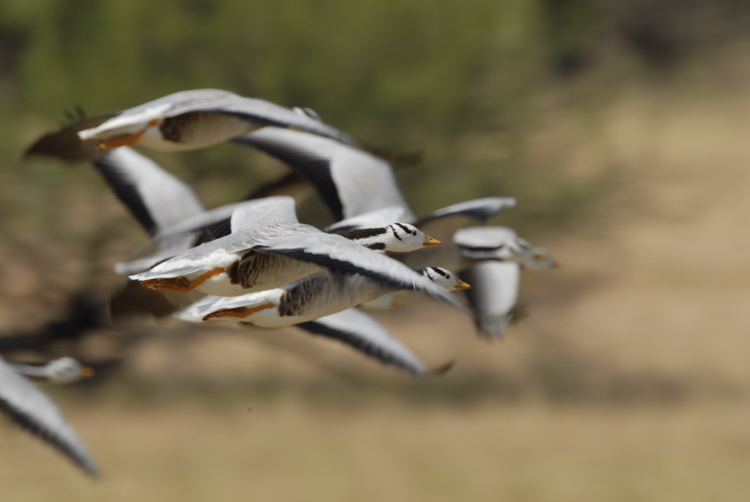
While at the far end of mainland India, in the Koonthankulam bird sanctuary, near the Kudankulam Nuclear Power Project, a huge congregation of the Bar-headed Goose is seen. Just a stone’s throw away from the sanctuary lies another freshwater lake called
the Kadankulam lake. These twin lakes are the preferred destinations of the Bar-headed goose, which has been revisiting this place every winter since last several years. About 2500 individuals of the Bar-headed Goose were found here in February 2014 and in
March 2016. Even more interesting part of this study was the spotting of some geese with collar bands in the midst of this huge congregation; at least 10 such geese were noticed. The collar bands were in green, red and yellow and were numbered.
The tagged birds
“The colour and the tag number signifies two important information”, says Dr. Balachandran, Deputy Director of Bombay Natural History Society (BNHS) and an internationally renowned bird researcher. “They represent the country which ringed the bird and
the year of ringing,” he adds. The bird with a green collar band around its neck is from Mongolia, and the one with the yellow collar is from China, and so on.
Ringing, tagging and satellite transmitter fixing are the techniques used by ornithologists to study the migratory pattern of birds, its flying behaviour and to monitor them. Dr. Balachandran, who is a well-known bird ringer, has ringed more than 2 lakh
birds and spotted at least 30 tagged birds that were from countries like Russia, China, Mongolia, Saudi Arabia, Oman and Iran. When birds migrate, he migrates, too. While the former migrate essentially for food and breeding, the latter does it to study them.
In non-migratory seasons, he settles in a small village called Agateeswaram. Since this village is very close to the Koonthankulam bird sanctuary, he finds ample opportunities to study resident birds during non-migratory seasons.
“If seeing the world’s highest-flying bird is a wonderful thing, then seeing them at your own place – right at your doorstep – is another amazing experience,” exclaims Dr. Balachandran.
Text and photo: J. Devaprakash
The author is Manager at NPCIL.
He is also a keen bird watcher and a wildlife photographer.
|
Bird Watching
When beauty knocked at my door
-Jitender Dhir
How I would feel when some beautiful woman or a special person knocks at my door, is just
what I felt few days back when the same thing happened in my birding world.
In the later morning , when I was at my home (west Delhi) , a distinct sound of black kites which shows a freaking emotion, caught my attention. I was aware that this is a sound of fear or danger to them mostly by some intruder entering their territory.
It raised my brows and I rushed to the spot with my gear and as expected the intruder was a lovely and majestic Crested serpent Eagle. This was the same bird I saw here two weeks back also but then was unable to photograph it. I was lucky this
time. This was the second visit of the bird in the area within fifteen days and that’s something which made me both happy and sad at same time. Happy because it was making regular visits here which is a gift for a birder and sad because movements
of such birds, which are more adapted to wild habitats, in urban settings mostly indicate decrease in their habitat. Crested serpent eagle is a distinct eagle with crested body , beautiful white bands on under parts of wings and tail. That’s why it
looks even more beautiful in flight. It feeds mainly on snakes (which give the name “serpent eagle”), frogs, lizards and small birds.

As kites were harassing it continuously , and it was continuously asking them to let it stay in their territory, I felt pity for it. I am sure if kites would spare it, then it may even nest here, as it was making regular visits and the area
has pretty good variety of big trees and other greenery. Birds which are adapted to urban areas usually see wild birds (specially a raptor) as threat and harass them away. So that’s one of the big reasons why wild birds may not be seen in urban
habitats. Even if they want to nest and share habitat, they are not allowed by urban ones. This is very sad not only to the bird looking for a habitat (specially today when habitat loss is a main concern) but also for a birder like me, who would
otherwise have got a chance to witness this beauty daily.
Even if a wild bird make itself adapted to urban habitats it has to compromise and compete with the urban ones making its survival challenging.
The crested serpent eagle mainly feeds on snakes and reptiles, so it is mainly found in dense forested areas. It is found in regions of thick vegetation of may be low lying hills or plains. It can also be found in other habitat types like open grasslands
,deciduous forests and others where there are large trees. It is absolutely rare to sight it in urban areas though not completely impossible. So I was lucky to have this rare bird sighted and not only once but multiple times with last one recently.
After much tolerance, the eagle ultimately took off and left the area. I can certainly see in its eyes , the words – I shall be back soon. I still await it to come again. Really it was an unexpected experience where “Beauty knocked at my door”.
Jitinder Dhir is a Birdwatcher and wildlife enthusiast from New Delhi. He can be contacted at jitenderdhir@indiatimes.com or at 91 9899848480
Note: At least 36 species of dry-land birds have been spotted in India’s coastal state of Kerala, known for its sultry weather, indicating a change in weather pattern, rapid urbanisation and deterioration in habitat,
says an analysis of eBird data (http://indiaclimatedialogue.net/2016/03/23/dry-land-birds-wing-wet-kerala/). Jitender Dhir's article calls for a similar analysis to be done in North India too.
|
Burning Issues
Scrubbing water clean
-S. Ananthanarayanan
Water’s capacity as a cleaning agent makes water itself a host to contaminants that are difficult to remove, says S.Ananthanarayanan.
Industry, pollution and the growing population are increasing both the demand and the scarcity of clean water. While river-fed sources are getting less accessible, ground water is also sinking deeper or getting contaminated. Conserving and reusing water
has become vital and technology to turn bad water to good has become more important than ever.
Marc Andelman, Massachusetts based inventor, Prof Tony Cass from Imperial College, London and Prof Sung Jae Kim from Seoul National University presented three new, nano technology based solutions for extracting potable water from inferior sources, at the
8th India Nano meet organised by the S&T Promotion Society of the Govt of Karnataka at Bengaluru on 8th March. The packed audience included industrialists, startups and students and Prof T Pradeep of IIT, Chennai, who conducted the meeting, pressed for emerging
technology to be picked up and put to use, for the benefit of the country and the world.
Capacitative de-ionisation
Marc Andelman’s innovation is an improvement of the method called capacitative de-ionisation, or CDI, where a pair of oppositely charged surfaces, the electrodes, fish out contaminants, mainly salt, from water which is made to flow between the charged
plates. The voltage used is low, and there is no current between the surfaces, but dissovled contaminants, which are split in the water medium into oppositely charged halves, called ‘ions’, drift to opposite ends, till the ends collect full charge and the
drifting of ions stops. While the water that flows through got purified when the charge was on, the surfaces can now be discharged, to release a concentrate of contaminants for disposal. CDI, which extracts dissolved contaminants, is energy efficient, compared
to other methods like distillation or the now common reverse osmosis (RO), which work the other way about, extracting water from a salt solution.

Marc explained that the material of the electrodes had to be porous, so that there was high surface area, and greater capacity to collect charge for the same voltage applied. A limitation of the basic design, however, was that when charged ions of the
contaminant piled up very near the electrodes, oppositely charged ions were also inserted into the region just beyond, a region called the diffuse layer, and this reduces the efficiency of extraction of contaminants. A first improvement has hence been to insert
an ‘ion exchange membrane’ which would not impede the movement of the contaminant ions, but acts as a barrier to the counter-current of opposite charges. This did improve efficiency, but the membrane is expensive and takes space in the water channel.
Mark’s innovation was to replace the membrane by directly coating the electrodes with a material which contains charged components that get drawn, half towards and half away from the charge on the electrodes. These separated charges create a layer that
behaves like the ion exchange charge barrier in keeping down the counter-current of charges being released from the electrodes. This treatment, of creating a ‘polarised electrode’, however, is a low cost procedure and the electrodes themselves are nano-porous
carbon, which could come from burnt coconut shells, Marc said.
Measuring contamination
Prof Tony Cass, chemical biologist, explained that arsenic poisoning of ground water, which is notorious in Bangla Desh, was in fact a problem the world over. And the great difficulty in its management was the complexity of detection and measurement. It
was hence a challenge to monitor large numbers of water borings, particularly as arsenic levels could change within a very short period of time. “You cannot manage anything, till you can measure it,” Prof Cass said, citing a remark made about air pollution
in the city of London
Prof Cass said the current methods of measuring sugar levels in blood and urine of diabetics became an example to emulate in assessment of arsenic levels. Testing for sugar used to be slow and cumbersome 30 years ago, but it could now be done very easily,
and fast, with a hand-held device by the patient herself. The secret of the advance was the discovery of an enzyme that reacted with glucose, and exclusively with glucose, to set free an electron, that formed a current which could be measured by a meter or
a counter. A light pin-prick to access the blood could then be automated to read out the glucose level, in a device that was now sold over the counter! And there is a strip of paper that can be dipped in urine and the colour shows the level of glucose.

Prof Cass, with his colleagues, Joanne Santini and Thomas Osborne, chanced upon a similar action of an enzyme that set electrons free while changing arsenic salts from one form to another. They have now devised a method to build a simple instrument, like
the glucometer for diabetics, which measures low levels of arsenic in water with good accuracy. “The device is not so good at high concentrations,” Prof Cass says, “but fortunately the area of interest is low contamination.”
Bio-inspiration
Prof Sung Jae Kim takes inspiration from coastal mangroves which flourish in salt, seawater, to devise ways of desalination as a source of fresh water, for human consumption or for irrigation. The current ways of large scale desalination are only distillation
or reverse osmosis, both of which are power intensive. It is hence attractive to desalinate without the use of power, except sunlight, maybe, like nature.
Mangroves
The process of osmosis is that when solutions of different concentration are separated by a semi-permeable membrane, which lets through the solvent but not the solute, the solvent is driven to pass from the lower concentration to the higher side. This
driving force, in fact, can support a higher column of greater concentration, which is what happens in a coastal fresh water well, which supports the pressure of salty sea water whose level is higher. In reverse osmosis, physical pressure which is greater
than the pressure of osmosis is exerted on the side of higher concentration, to drive the solvent, water in the case of brine, to the fresh water side.
The roots of coastal plants, which stand in salt water, are able to keep out the salt and take in fresh water, which then rises with the sap to the stem and leaves, using capillary forces. The work of Prof Sung Jae Kim and colleagues identifies the role
of capillaries, or very narrow channels, in attaining the separation of higher and lower concentrations, or an ‘ion concentration polarisation’, leading to an ‘ion depletion zone’ near nano-porous materials that are selectively permeable. A device based on
this effect has been found to achieve 90% reduction of salinity without an external power source. The group has carried out theoretical analysis and has come to conclusions of methods to commercialise the process.
Getting to the market
Prof T Pradeep, who moderated the event, spoke of the scale of the problem of water, which would soon, he said, dwarf other crises that humanity faces. A very low level of contamination, just one part in 1013, which works out to “one person in 10,000 times
the Indian population”, he said, renders water unfit for use. To purify water affordably and on a large scale was hence a priority. There was a case to create an institution to support research and to help ideas to be quickly commercialised, he said. But Marc
Andelman later observed that in the US, “there is zero R&D money in the USA for water tech, neither government nor corporate,” and he funded his own research by running an e-commerce side business!!
(Courtesy simplescience.in)
|
Did You Know ?
Birds in Pest Control
-K. Amina Bibi
Birds are considered as one of the indicators of environment as they are sensitive to habitat change. Birds are known for its diversity in their bright colors, distinct voice (calls). Birds act as an important factor of biodiversity.
Role of birds in spreading seeds results in plant dispersal which in turn results in increasing the forest cover. Likewise the role of birds as a pollinator plays an important role in fertilization and seeding of many plants and trees (Eg. Sun Bird carries
pollens from one tree to the other with its beak). We all know birds are flying creatures with various colored feathers. They eat fruits and nuts.
Did you know that birds eat insects and keeps pest in control naturally? Yes birds often act as an Army at the border to protect the nation. Birds in their glide, consume hundreds of insects, many of which are considered
as pests.
Birds in flight
Birds consume insects such as mosquitoes, beetles and moths to feed themselves and feed their young ones. Birds catch huge numbers of insects in their larval form, which are high in protein. Without birds, life would have turned miserable as many insects
feed on plant and animals (from grains to human blood). Hence birds play a critical role in reducing and maintaining populations of insects in natural systems.
Bird inviting perches
In a paddy field, the role of birds in pest control is enormous. Due to chemical version of agricultural practices, the network of birds in the paddy ecosystem has reduced. But we have scope of bring back the lost biodiversity. Use of organic manures
like farm yard manures (decomposed animal and plant wastes from a farm) in fields not only adds nutrients, but improves the micro climate to multiply microbes and soil borne organisms like earthworms. Soil with rich micro-flora and fauna results in good quality
soil (biological, physical and chemical properties). In due course of time the lost biodiversity can be rejuvenated.
Birds on perches
Placing stumps of Palm or Coconut trees as bird’s perch in Paddy fields have resulted in increased visits by birds. Bird’s perch is a place made available for the birds who love to eat insects. Birds have a feast satisfying their appetite from the
paddy field and in return keep harmful insects in control. If enough birds' perches are provided they (birds) act like warriors on duty. Cranes on the other hand do not need bird’s perch to do the military role, thanks a lot for the long legs they have.
Bird warrior on the look out
In one of my field visit in Nedungadu village of Karaikal District, U.T of Puducherry, I found fields with birds' perches. One field had many and found birds like King Crow, Black Bulbul, Mynas and sparrows sitting on the perches and feeding on insect
larvae. This act greatly reduces the cost of pest control for the farmer and gives SAFE FOOD to people.
Birds are a part of the WEB OF LIFE. Each part of the web of life has a crucial role to play. When such interaction of biodiversity happens, the need for pesticides ceases and paves way for Organic Farming and GREENER TOMORROW.
K. Amina Bibi is Agriculture Officer, Karaikal. (Pondicherry) and can be contacted at bornagainamina@gmail.com, mobile
9443525661
|
Forest and trees
When Will Corporates Bite The Bullet?
-Usha Nair
‘The superior man seeks what is right; the inferior one what is profitable’-Confucius
The reported clearance of over 1000 acres or more by the Art of Living on the eco-sensitive floodplains of the river Yamuna in India, for the purpose of holding a cultural festival, is the latest in a series of examples, of the scant respect given to environmental
issues by Corporates the world over. Last year, fires burned through 2.6m hectares of Indonesia, blanketing parts of Southeast Asia in a noxious haze that closed schools and disrupted flights. Various countries have been experiencing their worst winters in
decades, the hottest summers on record or the wettest season in centuries. These instances, and there are many more, beg the critical question-how many corporates globally, have a grander vision than the mere focus on the bottom-line of their balance sheets?
One of the crucial problems facing the world today is the indifference of large corporates towards maintaining the ecological equilibrium. ‘At the moment they(forests) are worth more dead than alive-for soya, beef, for palm oil and for logging, feeding the
demand from other countries’(Prince Charles).When will Corporates wake-up to the fact that economic sustainability is ecological sustainability?
 Trees cut in Mangar Forest area, Haryana. Photo by Sunil Harsana
Tropical rainforests cover 7% of the earth, but contain 50 % of the global biodiversity. Deforestation and forest degradation accounts for approximately 15% of the world’s greenhouse gas emissions. Land use change for agriculture is the main driver of
deforestation, and over two-thirds of the tropical deforestation is driven by mainly a few commodities: timber, palm oil, soya, paper & pulp, beef & leather, which in turn, contribute to approx.50% of the packaged products in the supermarkets. Forests 500,
a rating agency for rain forests, reports that an area of approx. 50 football fields are cleared every minute of every day. The call to Corporates, investors and Governments today is to remove deforestation from their global supply chains and switch to sustainable
procurement, production and financing options by 2020. The erosion of world’s natural capital has been going on for decades. By some estimates, the global economy is incurring natural capital costs of US$7.3 trillion/year, or 13% of global output. (CDP Worldwide)
Yet how many corporates are willing to alter/modify/introduce systemic changes to their business operations towards an environmentally sustainable economy. Today, there are agencies to assess and manage corporate exposures to environmental risks-so it is not
information or knowledge that is wanting!! But so long as emission reporting and commitments to reductions of gas emissions remain voluntary, and not mandatory, the pace of progress will remain tardy. It may take years for emission disclosures to become an
industry norm, as it remains on the back-burner, behind greater priorities of profitable operations and stakeholder satisfaction.
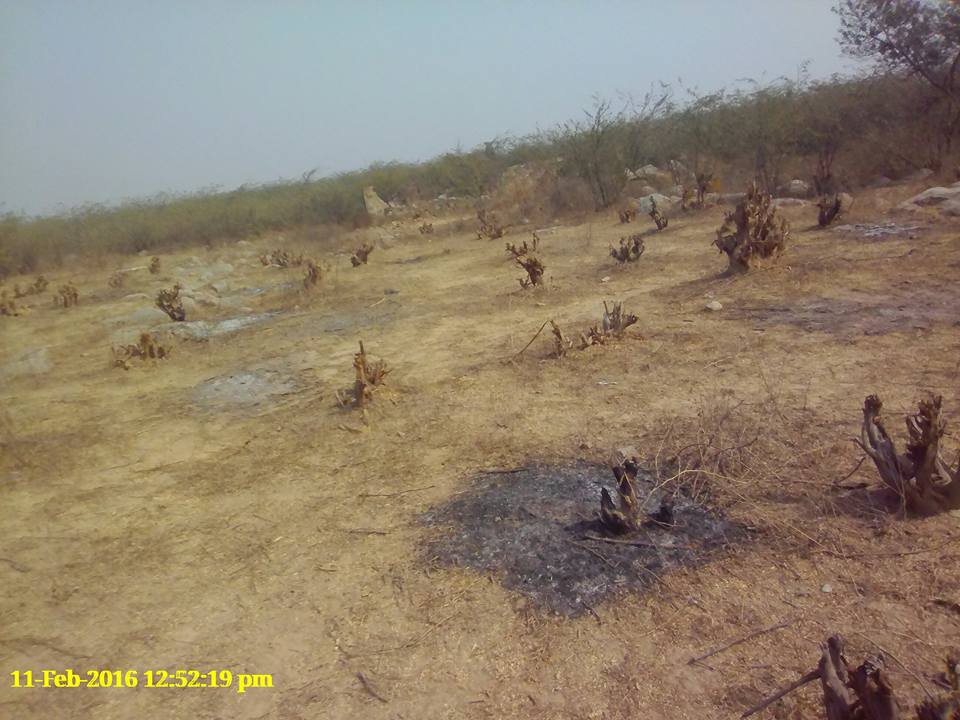 Trees burnt in Mangar forest area, Haryana. Photo by Sunil Harsana
Corporations, investors and governments must take responsibility to create the systemic changes we need for an environmentally sustainable economy. Greenpeace proclaims that if corporates have the power to destroy the world’s forests, they also have the
power to save them. They suggest that corporates should adopt a zero deforestation policy, clean-up the supply chain by holding suppliers accountable; incentivise usage of recycled wood, pulp, paper and fibre. Similarly investors can exhibit preference for
companies which adopt energy efficient process, decouple business growth from carbon emissions and integrate climate change into business strategies and operations. Governments must commit to work towards a low carbon and sustainable economy, and towards this
goal, they must adopt and enforce forest policies that promote reforestation, afforestation and reduction of deforestation. Even consumers can leverage the power of purchase by opting for recycled or certified wood products, support brands with zero deforestation
policies, and persuade other consumers to do the same.
Much debate has recently arisen over China’s and India’s responsibilities as related to climate protection. These two countries have repeatedly pleaded that their emissions be judged on a per-capita basis, since their per-capita emissions are very low
in comparison to those of the advanced Western nations, and they have thus argued that the rest of the world should not insist that they slash emissions. Thus Prime Minister Modi of India enunciates the principle of Common but Differentiated responsibilities
emphasising India’s right to grow even if net carbon emissions increase. In contrast, Western powers have maintained that the Chinese and Indian governments must take action if a global climate-protection plan is to be scientifically, economically, and politically
viable.
An increasing number of companies, investors and governments are acknowledging their role in the deforestation economy and have begun to make public commitments to prevent deforestation in agricultural supply chains. In September 2014, they met to sign
the New York Declaration on Forests, committing to support the goal to remove deforestation from agricultural production by 2020. This agreement mirrors an earlier pledge by the Consumer Goods Forum, a global alliance of 400 companies, to achieve zero net
deforestation supply chains by 2020. Similar commitments have been made within the financial community, most notably through the Banking Environment Initiative. The Heads of State from 196 countries, recognising the increasing threat of air pollution and the
importance of preserving forests, agreed at the recently concluded Conference on Climate Change in Paris in December 2015, to help developing countries by providing $100 billion a year from 2020 onwards for protecting their forests, reducing emissions from
deforestation and degradation (REDD+), and as incentives to replant. However, while these leaders have acknowledged the reputational, legislative and operational risks posed by deforestation, many have yet to act to ensure the commodities they produce or procure
do not contribute to further loss of tropical forests.
 Students of a municipal school in Mumbai participate in a sapling plantation drive organised by TIL on June 11, 2015 to commemorate World Environment Day
The research undertaken by ‘Forest 500’ supports the view that if the top global 500 corporate entities switch to sustainable alternatives, there would be a dramatic reduction in deforestation. The agency objectively identifies and ranks the top 500 entities
that have large-scale influence over forest risk commodity supply chains, holding these companies, investors, and governments accountable for their actions, by indicating the shortcomings and gaps in their commitments, and highlighting where greater action
is required to achieve overarching deforestation commitments. Their analysis indicates that while some companies like Nestle, Unilever, etc. have strong policies to reduce deforestation, other influential companies have still to take any action in this regard.
It is imperative that these powerful entities place their money and actions towards producing sustainably.
As zero deforestation policies gain momentum, companies and investors are increasingly aware that their operations, reputation and most worryingly, their bottom lines are at risk from environmental crisis. How long then will Corporates take to bite the
bullet?

Cartoon by Jasjyot Singh Hans (Usha Nair is a nature lover and can be reached at ushaenvironment@gmail.com)
|
General
Earth Day-2016
-Susan Sharma
Earth Day is coming up on April 22.
What is Earth Day?
April 22, 1970 marked the first Earth Day. It activated 20 million people from all walks of life to do something to save their common heritage – Earth.
The stage had been set for change by the publication of Rachel Carson’s New York Times bestseller Silent Spring in 1962. The book represented a watershed moment, selling more than 500,000 copies in 24 countries, and beginning to raise public awareness
and concern for living organisms, the environment and links between pollution and public health.
Earth Day 1970 gave voice to that emerging consciousness, channeling the energy of the anti-war protest movement and putting environmental concerns on the front page.
Today, more than one billion people worldwide participate in Earth Day activities each year, making it the largest civic observance anywhere in the world.
How are you going to commemorate Earth Day?
What are you or your organization doing to maintain a sustainable environment?
Do share your plans with us.
Send an email to us through "Contact Us" and we will publish your event in the upcoming events section.
Watch a one and a half minute video clip put together by us to start a conversation on Earth Day.
|
Urban Wildlife
Shikra Pairing
-Ajay Gadikar
This is an article about a pair of Shikra (Accipiter badius), birds that used to reside at the Bio-diversity nursery at the forest campus in Indore. This beautiful bird of prey is a resident species of India and is easily seen near human habitation apart
from forested areas.
I have been observing a pair of Shikra since two years, but last year only I was able to watch closely their breeding ecology. Their breeding period starts from February-March. The first thing that you notice about it is, they become very noisy during
this period, their occasional calls become very regular and they can be heard from a great distance as well.
Last year I saw their courtship behaviour just at the start of month of March, the same time when the Indian grey hornbill, rose ringed parakeets, coppersmith barbet all were also indulged in their breeding rituals. I must tell you that the Male and female
of this species are easily distinguishable, the Male has orange red eyes while the female has yellow eyes, also the female is slightly bigger in size.
Female shikra
In the breeding behaviour of the Shikra, the Male brings some catch (food) and offers it to the female. Once I have seen him offering a lizard to the female. The female came flying towards the Male and immediately accepted the feed and started to eat
it. As she ate the feed the Male tried to mount over and they started mating. They were making quite a noise as they were mating. The same phenomenon was seen twice when the male has offered one or other kill to the female.

Shikra male
Generally the kills are of small birds, squirrels, juveniles of Pigeon and dove. The same week I saw the female carrying small twigs to the nearby tree, I understood that she must be preparing the nest. The nest was on the higher canopy of the tree (almost
at a height of 10 meter). It was impossible to photograph the nest, but from a forest guard residence roof I was able to observe the behaviour closely. The nest seemed to have been built of thin sticks and twigs, more or less like a crow nest but a little
smaller than that, I also saw the female putting some green leaves inside the nest.
One week later I used to see the female mostly confined near the nest. Might be she had laid the eggs and was incubating the eggs. The Male used to bring the food daily and make calls to the female; she immediately leaves the nest and takes the feed.
The Male and female chase any intruder seen near the nest like the House Crow, Greater Coucal and the Rufous Treepie.
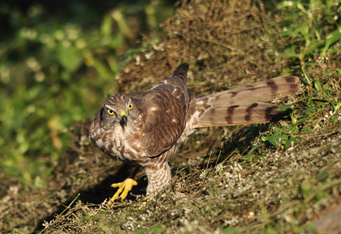
Shikra with a kill
Watching Shikra hunting down its prey is always fascinating. It is worth mentioning a particular event when my son and I watched how a Male Shikra bird catch a juvenile Red vented Bulbul. It was quite a hide and seek game. As I was watching a juvenile
Red vented Bulbul chick being fed by its parents inside a canopy, a male Shikra arrived. The parents of the juvenile immediately moved away and keptwatching from a distanc, while the juvenile kept himself hiding inside the canopy.
The Shikra was sensing that prey is there, but was not able to locate the exact position. We were placed in such a position that we can watch both the prey and the predator. It was a long waiting game; the juvenile was not at all making any movement.
The Shikra then changed its position and flew a bit near on an electric wire, now it seemed that the Shikra was able to locate its prey but he was aware that we were also watching the scenario, so he waited for a while, after a few minutes the Shikra moved
in a flash, cleanly he picked up the juvenile and flew on a nearby tree. As it happened both the parents Red vented Bulbul immediately flew where the Shikra had gone and started making noise and tried to disturb the Shikra keeping a safe distance from him.
It continued for around 10 minutes, the juvenile was alive but was in firm grip of the shikra’s talons, after ten minutes the Shikra who was very watchful and sensing what is happening around him, suddenly changed his stance and killed the juvenile and then
stared to tear out its feathers. The parent’s desperate attempt to save their chick was in vain and they left the place. Later the male shikra took the feed to the nest and offered it to the female.
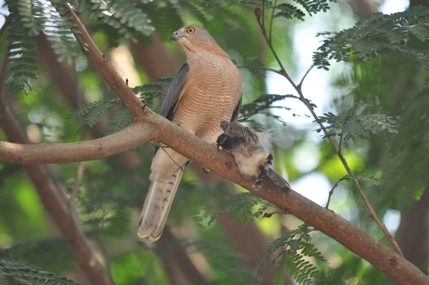 Male shikra with the catch
After some days I saw that the pair has raised two chicks, now the male and female both started bringing the food for the chicks. The chicks grew rapidly; it took almost 4 weeks for them to take their first flight, later
they started to take flight on the nearby branches and fight for their share whenever the parents bring feed for them.
The crows were chased frantically if they tried to come near the tree, within 8-10 days the fledglings started to fly hard and move away with their parents to some unknown location. The Shikra parents had raised the chicks
and given them the wings to venture in the wild.
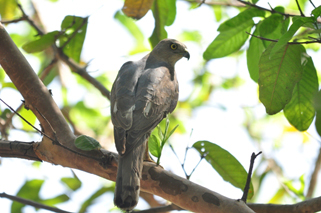
Female shikra
Ajay Gadikar is an observational naturalist from Indore. He can be contacted at ajay.gadikar@lmsin.com
|